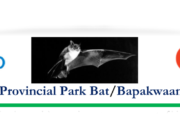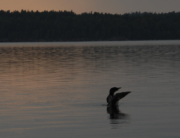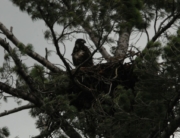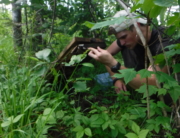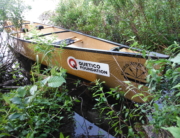by: Katie Tripp
Most of the summer was spent working on the Ontario Breeding Bird Atlas and moving songbird meters around the park. In addition to this work, other projects completed this summer include collecting depth and water clarity information from lake trout lakes so that each individual lake trout population’s risk from climate change can be assessed; sampling lakes for the presence of invasive Spiny Water Flea and monitoring trends in salamanders in the park. We also assisted the Lakehead University Quetico Foundation Research Partnership students in data collection for their thesis.
The 2021 Quetico Foundation Research team got off to a rough start when returning member Kelsey Atatise broke her wrist just prior to starting work. Originally, it was hoped Kelsey could join the team later but delays in her recovery meant she was unable to. This left Team Leader Katie Tripp as the sole member of the team for the summer but along with the field assistance of Quetico Provincial Park staff (including Keeley Sweitzer, Destinee Lafonde, Jack Davidson, Michael Davidson and Brian Jackson), most of the planned projects were completed.
Ontario Breeding Bird Atlas
The major focus of work in the early part of this season was collecting data to contribute to the Ontario Breeding Bird Atlas. Every 20 years since 1981, a survey of the distribution and relative abundance of Ontario’s bird populations is conducted which is known as the Breeding Bird Atlas. The surveys occur over a five-year period with the current survey happening from 2021 to 2025.
One concern of previous surveys is a lack of data from less accessible wilderness parks so there has been an effort to collect more data from Quetico for this survey. Bird songs were recorded using song meters and much of the time from May to July was spent moving the meters to cover 25 sites within each of 4 different 10km x10km squares (total of 100 sites). The recordings will be analyzed over the winter by experienced birders to determine the species found at each site.
The placement of the meters is different in Quetico than in most other places as all sites are accessed via canoe. This involved several canoe trips in the park to move meters to their different sites while following the time restrictions of the breeding season and the duration of time needed for each meter at each site (minimum 5 days).
Lake Trout Vulnerability Assessments
Lake trout prefer cold water and tend to live in the coldest and deepest parts of lakes. As climate change pushes forward, the habitat for lake trout in lakes will change as they get warmer. But not all lakes are created equal and different lakes will be impacted differently by a warming climate and warmer water. Smaller lakes with only a small section of deep water will warm more quickly than a larger bowl of deep water.
To estimate the rate at which these lakes will warm, a few data points are collected. The main one is the maximum depth of the lake as well as an estimate of the contour lines of depth. This leads to estimating the volume of water in the lake and can be used to estimate how quickly the lake will warm. Data on mineral content and water clarity are also collected.
Collecting this data for dozens of lakes is an ongoing project.


